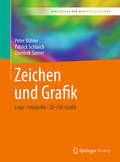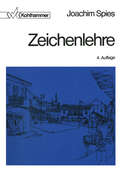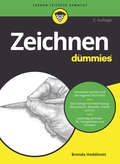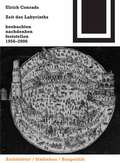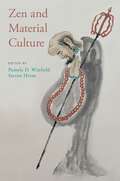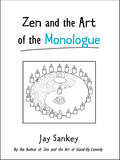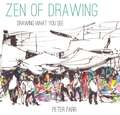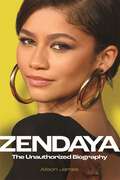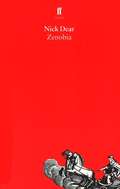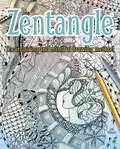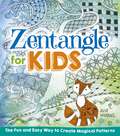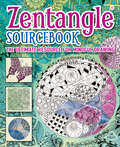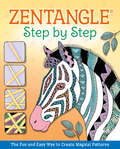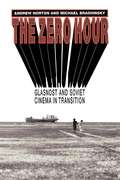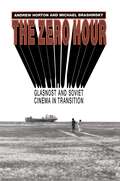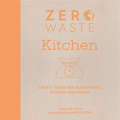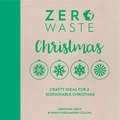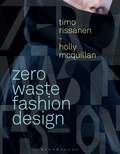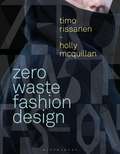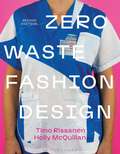- Table View
- List View
Zeichen und Grafik: Logo - Infografik - 2D-/3D-Grafik (Bibliothek der Mediengestaltung)
by Peter Bühler Patrick Schlaich Dominik SinnerDieser Band der „Bibliothek der Mediengestaltung“ behandelt die Gestaltung von Zeichen wie Piktogramme, Icons und Logos sowie von Infografiken. Außerdem thematisiert der Band die Erstellung von 2D- und 3D-Grafiken. Für diese Bibliothek wurden die Themen des Kompendiums der Mediengestaltung neu strukturiert, vollständig überarbeitet und in ein handliches Format gebracht. Leitlinien waren hierbei die Anpassung an die Entwicklungen in der Werbe- und Medienbranche sowie die Berücksichtigung der aktuellen Rahmenpläne und Studienordnungen sowie Prüfungsanforderungen der Ausbildungs- und Studiengänge.Die Bände der „Bibliothek der Mediengestaltung“ enthalten zahlreiche praxisorientierte Aufgaben mit Musterlösungen und eignen sich als Lehr- und Arbeitsbücher an Schulen sowie Hochschulen und zum Selbststudium.
Zeichenlehre
by Joachim SpiesDie Techniken und Darstellungsarten des Freihandzeichnens und ihre Anwendung werden leicht verständlich und mit vielen Beispielen versehen angeboten: Strich- und Lockerungsübungen, Punkt-Linie-Fläche / Struktur-Raster-Ornament / Körper-Stilleben, Raum-Innenraum / Landschaften / Figur-Portrait-Tiere / Kompositionen und Ordnungssystemschriften. Das Buch ist unentbehrlich zur Erlernung anschaulichen visuellen Denkens als Grundlage der Architektenausbildung und bei jeglicher künstlerischen Betätigung
Zeichnen für Dummies (Für Dummies)
by Brenda HoddinottImmer wieder ist es faszinierend, wie schnell manche Menschen die schönsten Zeichnungen auf Papier zaubern können. Ein paar Striche, Linien und auf wundersame Art und Weise entstehen Gegenstände, Landschaften und Gesichter. Sehr beeindruckend. »Zeichnen für Dummies« beginnt mit den Grundlagen und arbeitet sich dann zu immer komplexeren Darstellungen vor. Den Lesern wird systematisch erklärt, wie sie den Stift führen müssen, damit sie ihre Motive mit einem Schuss Persönlichkeit aufs Papier bringen können.
Zeit des Labyrinths: beobachten, nachdenken, feststellen 1956-2006 (Bauwelt Fundamente #136)
by Ulrich ConradsDer wahre Architekturkritiker, hat Ulrich Conrads einmal gesagt, kenne nur einen Maßstab, den Maßstab 1:1. Der Kritiker lasse sich zwar im Vorhinein von glänzend gesehenen Fotos informieren, jedoch nicht täuschen, denn er arbeite an Ort und Stelle. Er berichte nur über Bauten, die er selbst aus wechselnden Distanzen gesehen, mehrmals umschritten und all ihre Räume und Raumfolgen von den Kellern bis unters Dach in Ruhe begangen hat. Eine notwendige Ergänzung: Der wahre Architekturkritiker beschränkt sich nicht auf sein Ressort. Ulrich Conrads hat seine Texte stets als Einmischung in die öffentliche Debatte über Architektur und Stadt verstanden. Als kritisches Reden über das, was vielfach als nicht zur Sache gehörend beschwiegen wird. Der Band versammelt Artikel, Aufsätze, Vorträge und Briefe Ulrich Conrads aus den Jahren 1956-2006 zu zeitgenössischen Gebäuden, wie der Kirche Le Corbusiers in Ronchamp und bedeutenden Architekten der Zeit, wie beispielsweise Hans Scharoun.
Zen and Material Culture
by Pamela D. Winfield Steven HeineThe stereotype of Zen Buddhism as a minimalistic or even immaterial meditative tradition persists in the Euro-American cultural imagination. This volume calls attention to the vast range of "stuff" in Zen by highlighting the material abundance and iconic range of the Soto, Rinzai, and Obaku sects in Japan. Chapters on beads, bowls, buildings, staffs, statues, rags, robes, and even retail commodities in America all shed new light on overlooked items of lay and monastic practice in both historical and contemporary perspectives. Nine authors from the cognate fields of art history, religious studies, and the history of material culture analyze these "Zen matters" in all four senses of the phrase: the interdisciplinary study of Zen's matters (objects and images) ultimately speaks to larger Zen matters (ideas, ideals) that matter (in the predicate sense) to both male and female practitioners, often because such matters (economic considerations) help to ensure the cultural and institutional survival of the tradition. Zen and Material Culture expands the study of Japanese Zen Buddhism to include material inquiry as an important complement to mainly textual, institutional, or ritual studies. It also broadens the traditional purview of art history by incorporating the visual culture of everyday Zen objects and images into the canon of recognized masterpieces by elite artists. Finally, the volume extends Japanese material and visual cultural studies into new research territory by taking up Zen's rich trove of materia liturgica and supplementing the largely secular approach to studying Japanese popular culture. This groundbreaking volume will be a resource for anyone whose interests lie at the intersection of Zen art, architecture, history, ritual, tea ceremony, women's studies, and the fine line between Buddhist materiality and materialism.
Zen and the Art of the Monologue
by Jay SankeyJay Sankey--stand-up comic, magician, and cartoonist--is back with another book for performers. Building on the success of his Zen and the Art of Stand-up Comedy, Jay is moving further into the uncharted wilds of solo performance.
Zen and the Art of the Monologue
by Jay SankeyJay Sankey--stand-up comic, magician, and cartoonist--is back with another book for performers. Building on the success of his Zen and the Art of Stand-up Comedy, Jay is moving further into the uncharted wilds of solo performance.
ZEN & MATERIAL CULTURE C
by Pamela D. Winfield and Steven HeineThe stereotype of Zen Buddhism as a minimalistic or even immaterial meditative tradition persists in the Euro-American cultural imagination. This volume calls attention to the vast range of "stuff" in Zen by highlighting the material abundance and iconic range of the Soto, Rinzai, and Obaku sects in Japan. Chapters on beads, bowls, buildings, staffs, statues, rags, robes, and even retail commodities in America all shed new light on overlooked items of lay and monastic practice in both historical and contemporary perspectives. Nine authors from the cognate fields of art history, religious studies, and the history of material culture analyze these "Zen matters" in all four senses of the phrase: the interdisciplinary study of Zen's matters (objects and images) ultimately speaks to larger Zen matters (ideas, ideals) that matter (in the predicate sense) to both male and female practitioners, often because such matters (economic considerations) help to ensure the cultural and institutional survival of the tradition. Zen and Material Culture expands the study of Japanese Zen Buddhism to include material inquiry as an important complement to mainly textual, institutional, or ritual studies. It also broadens the traditional purview of art history by incorporating the visual culture of everyday Zen objects and images into the canon of recognized masterpieces by elite artists. Finally, the volume extends Japanese material and visual cultural studies into new research territory by taking up Zen's rich trove of materia liturgica and supplementing the largely secular approach to studying Japanese popular culture. This groundbreaking volume will be a resource for anyone whose interests lie at the intersection of Zen art, architecture, history, ritual, tea ceremony, women's studies, and the fine line between Buddhist materiality and materialism.
Zendaya: The Unauthorized Biography
by Alison JamesDiscover how Zendaya conquered the worlds of film, TV and fashion to become the face of a generation. This is her life story, as never told before. Zendaya is a phenomenon. Beginning as a precocious child star on the Disney Channel, she has since graduated to adult roles in some of the biggest movies of the last five years, including The Greatest Showman, Dune and Marvel’s Spider-Man trilogy. In television, she is the star of Euphoria, which has become the second most-watched HBO show of all time after Game of Thrones – in large part thanks to her presence. Today she is, according to some industry analysts, "the most popular actor in the world".In this riveting and in-depth biography from the publishers of Harry, Adele and Billie Eilish, journalist and author Alison James explores every aspect of Zendaya’s life and career to date. Featuring a stunning, full-colour photographic plate section and spanning everything from her early forays into music, to her sensational ascent in the fashion world and her high-profile personal life – including her relationship with Spider-Man co-star Tom Holland – this is the most complete portrait yet of one of the world’s hottest stars.
Zenobia: Art Of Success; In The Ruins; Zenobia; Turn Of The Screw
by Nick DearThe Syrian desert. Third century AD. Zenobia, warrior Queen of Palmyra, moves her forces into battle with Aurelian, Emperor of Rome. Meanwhile, her son is engaged in bizarre chemical experiments with Porphyry, a philosophy student with his own secret.A story of love and adventure at the time of the decline of Imperial Rome as Zenobia makes a stand for independence against the Empire.Zenobia was produced by the Royal Shakespeare Company and premiered at the Young Vic, London, in August 1995.
Zentangle: The inspiring and mindful drawing method
by Jane MarbaixAimed at beginners, this book shows how beautiful images can be created from repeating patterns. Accredited Zentangle teacher Jane Marbaix demonstrates a range of patterns one step at a time and offers a sourcebook of her own designs to inspire tanglers to try something different. Proven to reduce stress and enhance creativity in people of all ages, Zentangle does not require a background in practical art or expensive materials to produce pleasing results.
Zentangle for Kids: The Fun and Easy Way to Create Magical Patterns
by Jane MarbaixUnlock your creativity with this fun and inspiring book! Clear step-by-step instructions make the tangles easy to master and fun to do, and the book is filled with beautiful illustrations and scenes that young tanglers can make their own. Special project pages also show readers how to use their tangle artworks to create gorgeous decorations, cards and gifts. Perfect for creative kids aged 8 and up.
Zentangle® Sourcebook: The ultimate resource for mindful drawing
by Jane MarbaixPacked with how-tos of more than 70 popular tangles, this handy reference book is the perfect guide for aspiring tanglers.Each easy-to-follow step-out is complemented by beautiful and original Zentangle Inspired Artworks showing how your tangles can be combined.A wealth of visual treats provides endless inspiration and stimulation for both aficionados and beginners alike.
Zentangle® Step By Step: The Fun and Easy Way to Create Magical Patterns
by Hannah GeddesYou'll be a Zentangle® master in no time with this brilliant book!Learn how to draw a fantastic collection of tangles before bringing these together to create your own spectacular Zentangle® Inspired Artworks.Illustrated by a Certified Zentangle® Teacher and packed with tips, techniques, and simple step-by-step instructions, this book contains everything you ever wanted to know about this fun and creative art form.
Zero-carbon Homes: A Road Map
by Joanna WilliamsHousing is a major contributor to CO2 emissions in Europe and America today and the construction of new homes offers an opportunity to address this issue. Providing homes that achieve "zero carbon", "carbon neutral", "zero-net energy" or "energy-plus" standard is becoming the goal of more innovative house-builders globally, whilst energy providers seek to decarbonise the energy supply to new and existing development. Various new technical systems for achieving these goals are beginning to emerge. For example the passive house whose energy requirement for space heating and cooling is almost zero; the smart grid that has revolutionized the management of energy, whilst enabling the connection of small-scale, renewable energy producers and electric vehicles to the grid; or the European super-grid which will enable zero carbon energy to be generated in the Sahara desert and stored in Norway. This book explores the diverse approaches that are being adopted around the world to deliver zero carbon homes and the different societal systems and geographic circumstances in which they have developed. It postulates a roadmap for delivering zero carbon homes, together with a toolbox approach for policy and practice to suit particular national and local circumstances. A series of case studies are presented that offer lessons for delivering zero carbon homes. These examples are also used to demonstrate how prototype systems can move into the mainstream. The book highlights some of the instruments and mechanisms that could be used to support this transformation and addresses the wider implications of introducing these innovative systems in terms of industry, lifestyle and urban form.
Zero-carbon Homes: A Road Map
by Joanna WilliamsHousing is a major contributor to CO2 emissions in Europe and America today and the construction of new homes offers an opportunity to address this issue. Providing homes that achieve "zero carbon", "carbon neutral", "zero-net energy" or "energy-plus" standard is becoming the goal of more innovative house-builders globally, whilst energy providers seek to decarbonise the energy supply to new and existing development. Various new technical systems for achieving these goals are beginning to emerge. For example the passive house whose energy requirement for space heating and cooling is almost zero; the smart grid that has revolutionized the management of energy, whilst enabling the connection of small-scale, renewable energy producers and electric vehicles to the grid; or the European super-grid which will enable zero carbon energy to be generated in the Sahara desert and stored in Norway. This book explores the diverse approaches that are being adopted around the world to deliver zero carbon homes and the different societal systems and geographic circumstances in which they have developed. It postulates a roadmap for delivering zero carbon homes, together with a toolbox approach for policy and practice to suit particular national and local circumstances. A series of case studies are presented that offer lessons for delivering zero carbon homes. These examples are also used to demonstrate how prototype systems can move into the mainstream. The book highlights some of the instruments and mechanisms that could be used to support this transformation and addresses the wider implications of introducing these innovative systems in terms of industry, lifestyle and urban form.
The Zero Hour: Glasnost and Soviet Cinema in Transition
by Andrew Horton Michael BrashinskyNow faced with the "zero hour" created by a new freedom of expression and the dramatic breakup of the Soviet Union, Soviet cinema has recently become one of the most interesting in the world, aesthetically as well as politically. How have Soviet filmmakers responded to the challenges of glasnost? To answer this question, the American film scholar Andrew Horton and the Soviet critic Michael Brashinsky offer the first book-length study of the rapid changes in Soviet cinema that have been taking place since 1985. What emerges from their collaborative dialogue is not only a valuable work of film criticism but also a fascinating study of contemporary Soviet culture in general. Horton and Brashinsky examine a wide variety of films from BOMZH (initials standing for homeless drifter) through Taxi Blues and the glasnost blockbuster Little Vera to the Latvian documentary Is It Easy to Be Young? and the "new wave" productions of the "Wild Kazakh boys." The authors argue that the medium that once served the Party became a major catalyst for the deconstruction of socialism, especially through documentary filmmaking. Special attention is paid to how filmmakers from 1985 through 1990 represent the newly "discovered" past of the pre-glasnost era and how they depict troubled youth and conflicts over the role of women in society. The book also emphasizes the evolving uses of comedy and satire and the incorporation of "genre film" techniques into a new popular cinema. An intriguing discussion of films of Georgia, Estonia, Latvia, Lithuania, and Kazakhstan ends the work.
The Zero Hour: Glasnost and Soviet Cinema in Transition
by Andrew Horton Michael BrashinskyNow faced with the "zero hour" created by a new freedom of expression and the dramatic breakup of the Soviet Union, Soviet cinema has recently become one of the most interesting in the world, aesthetically as well as politically. How have Soviet filmmakers responded to the challenges of glasnost? To answer this question, the American film scholar Andrew Horton and the Soviet critic Michael Brashinsky offer the first book-length study of the rapid changes in Soviet cinema that have been taking place since 1985. What emerges from their collaborative dialogue is not only a valuable work of film criticism but also a fascinating study of contemporary Soviet culture in general. Horton and Brashinsky examine a wide variety of films from BOMZH (initials standing for homeless drifter) through Taxi Blues and the glasnost blockbuster Little Vera to the Latvian documentary Is It Easy to Be Young? and the "new wave" productions of the "Wild Kazakh boys." The authors argue that the medium that once served the Party became a major catalyst for the deconstruction of socialism, especially through documentary filmmaking. Special attention is paid to how filmmakers from 1985 through 1990 represent the newly "discovered" past of the pre-glasnost era and how they depict troubled youth and conflicts over the role of women in society. The book also emphasizes the evolving uses of comedy and satire and the incorporation of "genre film" techniques into a new popular cinema. An intriguing discussion of films of Georgia, Estonia, Latvia, Lithuania, and Kazakhstan ends the work.
The Zero Hour: Glasnost and Soviet Cinema in Transition
by Andrew Horton Michael BrashinskyNow faced with the "zero hour" created by a new freedom of expression and the dramatic breakup of the Soviet Union, Soviet cinema has recently become one of the most interesting in the world, aesthetically as well as politically. How have Soviet filmmakers responded to the challenges of glasnost? To answer this question, the American film scholar Andrew Horton and the Soviet critic Michael Brashinsky offer the first book-length study of the rapid changes in Soviet cinema that have been taking place since 1985. What emerges from their collaborative dialogue is not only a valuable work of film criticism but also a fascinating study of contemporary Soviet culture in general. Horton and Brashinsky examine a wide variety of films from BOMZH (initials standing for homeless drifter) through Taxi Blues and the glasnost blockbuster Little Vera to the Latvian documentary Is It Easy to Be Young? and the "new wave" productions of the "Wild Kazakh boys." The authors argue that the medium that once served the Party became a major catalyst for the deconstruction of socialism, especially through documentary filmmaking. Special attention is paid to how filmmakers from 1985 through 1990 represent the newly "discovered" past of the pre-glasnost era and how they depict troubled youth and conflicts over the role of women in society. The book also emphasizes the evolving uses of comedy and satire and the incorporation of "genre film" techniques into a new popular cinema. An intriguing discussion of films of Georgia, Estonia, Latvia, Lithuania, and Kazakhstan ends the work.
Zero Waste: Crafty ideas for sustainable kitchen solutions (Zero Waste #2)
by Emma Friedlander-Collins Christine LeechTurn your kitchen into a waste-free zone with these crafty solutions for everything from 'unpaper' towels to reusable kitchen wipes and clever storage solutions. The zero waste movement is huge and this collection will help you to craft your own zero waste solutions - with just a few craft skills you will be able to turn your unwanted waste into storage and cleaning items for your kitchen. The kitchen is the heart of our homes and finding ways to make it feel healthy and wholesome are really important. From leftover food scraps to the endless packaging that our food comes in, there's so much that goes on in a kitchen and it's the place in our homes where we generate the mosts waste. Make your kitchen more sustainable with some clever craft ideas for reusing, upcycling and transforming waste. Whether you're a committed crafter or new to making, there is something for everyone no matter what your skill level is. Choose from projects and tutorials for the kitchen including sewing, crochet, patchwork, upcycling and reuse ideas. There are also some projects that require cutting, sticking and even drilling thrown in for good measure: learning how to do little bits of everything will give you a 'toolkit' to think creatively about how to reuse everyday things as you progress on your journey to zero waste living. Learn how to use up fabric scraps and old linen to create beeswax wraps for storing food; make your own paper caddy liners for food waste and create pots for growing kitchen herbs from empty bottles. Create a unique and practical apron from an old pair of thrifted curtains and sew some handy storage ideas for the family using pockets rescued from unwanted clothes. Upcycling and reuse gurus Emma Friedlander-Collins and Christine Leech show you how to turn your kitchen into a zero-waste zone with step-by-step instructions and some clever crafting. Packed full of original ideas, Zero Waste: Kitchen will help you to live the zero-waste way and improve your efforts to reduce, reuse and recycle while at the same time having fun.
Zero Waste: Crafty ideas for a sustainable Christmas (Zero Waste #3)
by Emma Friedlander-Collins Christine LeechCelebrate Christmas the zero-waste way with these crafty solutions for everything from Christmas tree decorations to advent calendars. The zero-waste movement is huge and this collection of crafty ideas will help you to create your own zero waste solutions for a sustainable Christmas. It’s time to reclaim Christmas - this collection is all about using the things around you to bring festive cheer to your home. It’s about crafting and creating together and using what you’ve got to make unique, unusual items that you can enjoy year after year. By crafting your zero-waste Christmas you are also creating memories – something that cannot be bought online. Upcycling and reuse gurus Emma Friedlander-Collins and Christine Leech show you how to turn Christmas into a zero-waste experience with step-by-step instructions and some clever crafting. Whether you’re a committed crafter or new to making, there is something for everyone no matter what your skill level is. Choose from projects and tutorials for a sustainable Christmas including sewing, crochet, upcycling and reuse ideas. You don’t need to have lots of craft skills to create these projects, there are step-by-step instructions for each one. There are also instructions for the basic craft techniques such as crochet and embroidery so you can get stuck in straightaway. There are four different Christmas themed chapters: Hot; Frosty; Skandi and Retro so you pick your favourite style or mix and match for festive mash-up! Projects include Coffee Cup Baubles; a minimalist wreath made using an old cake tin; a milk carton advent calendar and some magical fairy lights made using takeaway containers. Choose your favourite projects from this collection of 24 projects including no-waste decorations for the tree and zero-waste gift wrap. Packed full of original ideas, Zero Waste: Christmas will help you to celebrate the zero-waste way and improve your efforts to reduce, reuse and recycle while at the same time having fun.
Zero Waste Fashion Design (Required Reading Range)
by Timo Rissanen Holly McQuillanZero Waste Fashion Design combines research and practice to introduce a crucial sustainable fashion design approach.Written by two industry leading pioneers, Timo Rissanen and Holly McQuillan, the book offers flexible strategies and easy-to-master zero waste techniques to help you develop your own cutting edge fashion designs.Sample flat patterns and more than 20 exercises will reinforce your understanding of the zero waste fashion design process. Beautifully illustrated interviews with high-profile, innovative designers, including Winifred Aldrich, Rickard Lindqvist and Yeohlee Teng, show the stunning garments produced by zero waste fashion design.Featured topics include: The criteria for zero waste fashion design Manufacturing zero waste garments Adapting existing designs for zero waste Zero waste designing with digital technologies
Zero Waste Fashion Design (Required Reading Range Ser.)
by Timo Rissanen Holly McQuillanZero Waste Fashion Design combines research and practice to introduce a crucial sustainable fashion design approach.Written by two industry leading pioneers, Timo Rissanen and Holly McQuillan, the book offers flexible strategies and easy-to-master zero waste techniques to help you develop your own cutting edge fashion designs.Sample flat patterns and more than 20 exercises will reinforce your understanding of the zero waste fashion design process. Beautifully illustrated interviews with high-profile, innovative designers, including Winifred Aldrich, Rickard Lindqvist and Yeohlee Teng, show the stunning garments produced by zero waste fashion design.Featured topics include: The criteria for zero waste fashion design Manufacturing zero waste garments Adapting existing designs for zero waste Zero waste designing with digital technologies
Zero Waste Fashion Design (Required Reading Range Ser.)
by Timo Rissanen Holly McQuillanZero Waste Fashion Design combines practical examples, flat patterns and more than 20 exercises to help you incorporate this sustainable technique into your portfolio. There are also beautifully illustrated interviews with innovative designers, including Richard Lindgvist, Mary Beth Bentaha and Daniel Desanto to show how sustainable practice continues to evolve within industry.Industry pioneers, Timo Rissanen and Holly McQuillan, offer flexible strategies and easy-to-master zero waste techniques to help you develop your own cutting-edge fashion designs. This updated edition includes new content on integrating 3D design into a zero waste process, additional coverage of the historical context of zero waste around the world, and expands on the related technique of subtraction cutting to make this the ultimate practical guide to sustainable fashion design.
